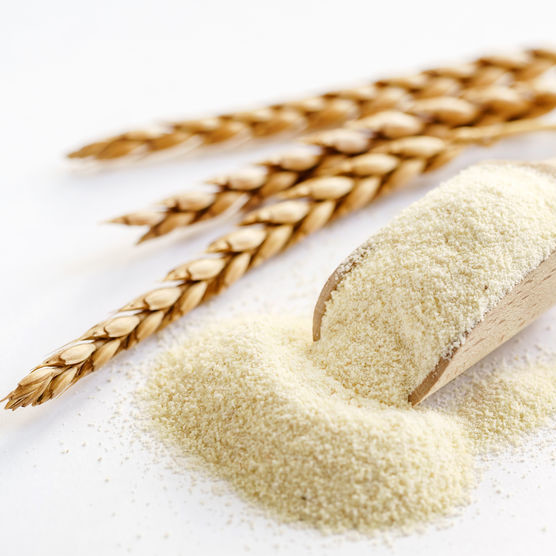Semolina
What is Semolina?
Semolina is a coarse flour made from high protein durum wheat (Triticum turgidum L. var. durum). It has a mild and earthy aroma and is mainly used in high-quality pasta, spaghetti, baguettes, or batards.1
Bread made with durum wheat semolina flour is characterized by:
- Fine and uniform crumb structure
- Desirable taste
- Long shelf life
Origin
The word ‘semolina’ comes from the latin ‘simila’ which means flour. It is obtained from durum wheat and is believed to have originated in Central Europe and the Near East around 7000 BC.1
Nutrition2
Typical composition of this type of flour is:
- Starch: 72.8%
- Protein: 12.7%
- Water: 12.7%
- Dietary fiber: 3.9%
- Lipids: 1.1%
Other nutritional components include minerals such as calcium, iron, magnesium, phosphorus, potassium, sodium, zinc and copper. Vitamins include thiamin, riboflavin, niacin, pantothenic acid and folate.
Function
In baked goods, semolina has the following functions:
- Structure: unlike common flours, the protein fraction of durum wheat is very weak and less extensible. When added at high levels, the gluten cannot form the stable network required for good bread volume. Surfactants such as steoryl lactate are often used to improve the volume of bread made with this flour.
- Color: The pale yellow pigmentation of this flour is due to the presence of carotenoids. These provide its desirable color in pasta and bread applications.
- Flavor: it adds a nutty and sweet flavor.
Commercial production3
Durum wheat milled to coarse granulation is used to produce this flour. The process includes a series of steps: grain cleaning, tempering, milling, sifting, purification and packaging. Semolina specifications vary with production regions and the flour’s end use. In the US, durum semolina should contain at least 90% of the milled particles greater than 180 μm (80 mesh).
Application
This wheat is known as “pasta wheat,” it’s most common application. However it is also used in baking other dishes:
- Baked goods: spaghetti, baguette, batard, thin-crust pizza, ricotta dumplings, loaf bread, biscuit, gnocchi
- Dishes: savory, sweet
Incorporating semolina flour into wheat flour creates a sweet, almost wine-like aroma. Good quality flat breads are made in some mediterranean countries using this flour and a short fermentation processes.
FDA regulation
The FDA article 21CFR137.3204 defines semolina standards in food applications.
References
- Triticum (wheat genus). Biodiversity explorer. https://web.archive.org/web/20081010083956/http://www.biodiversityexplorer.org/plants/poaceae/triticum.htm. Accessed 08 Nov 2019.
- Semolina, unenriched. 01 April 2019. https://fdc.nal.usda.gov/fdc-app.html#/food-details/168933/nutrients. Accessed 08 Nov 2019.
- Grant, C., Cubadda, F., Carcea, M., Pogna, N. E., and Gazza, L. Vitamins, Minerals, and Nutritional Value of Durum Wheat. In Durum Wheat: Chemistry and Technology, 2nd edition (pp.125-137), AACC International Press, 2012.
- “CFR – Code of Federal Regulations 21CFR137.320” Accessdata.fda.gov. 01 Apr. 2019. https://www.accessdata.fda.gov/scripts/cdrh/cfdocs/cfcfr/CFRSearch.cfm?fr=137.320. Accessed 8 Nov 2019.


